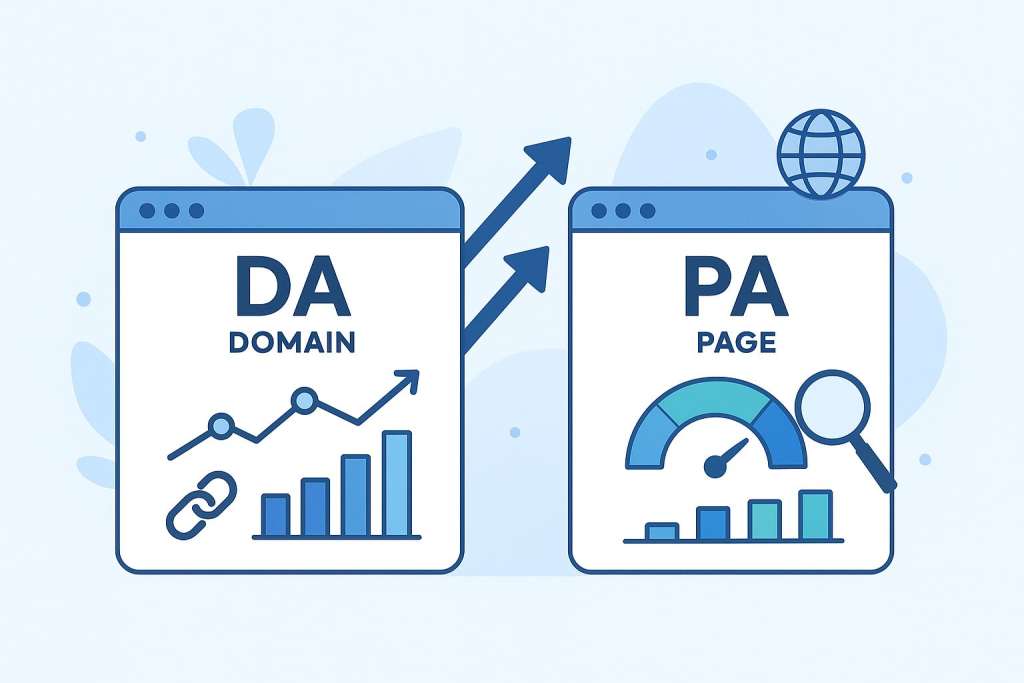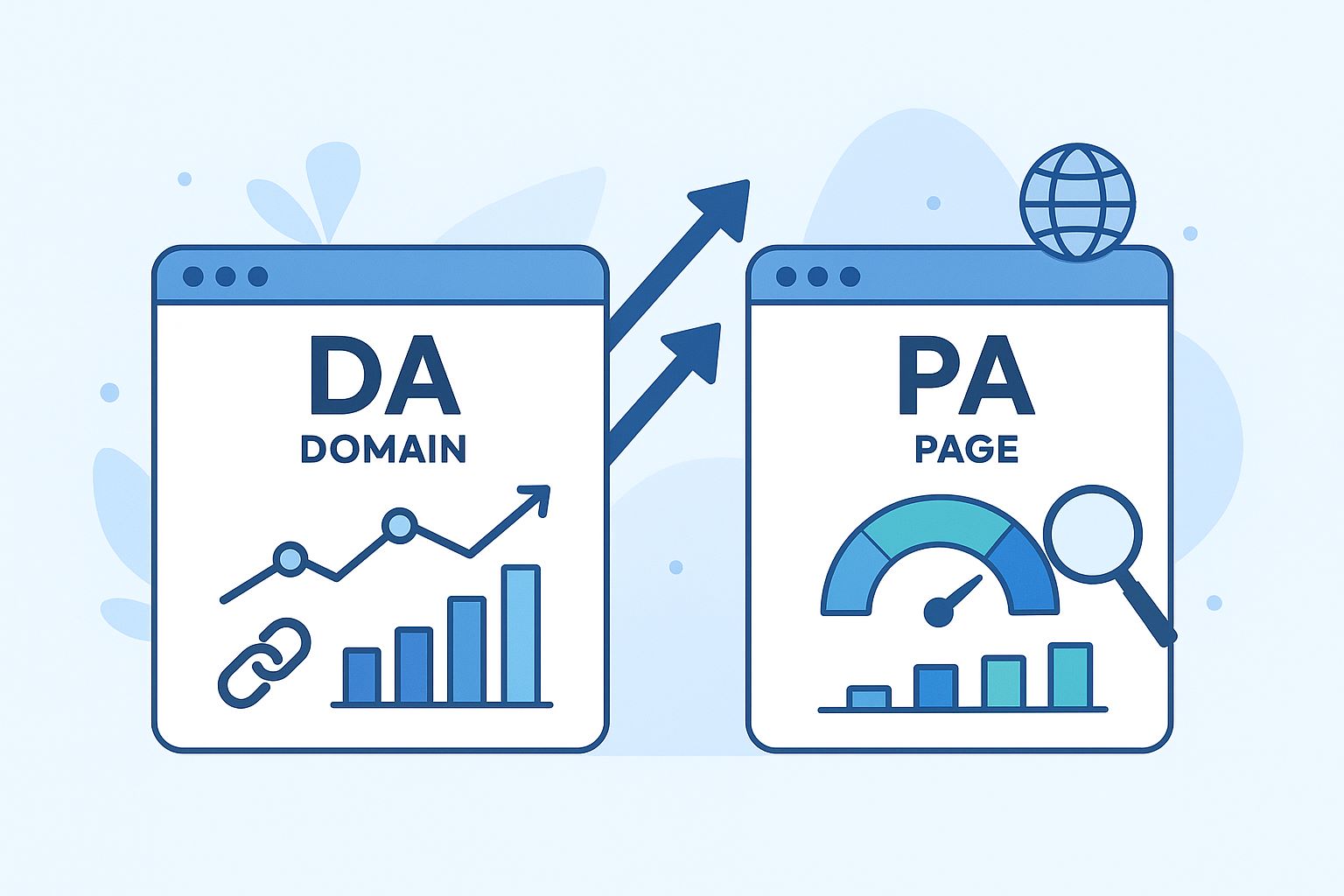When digital marketers talk about SEO, Domain Authority (DA) and Page Authority (PA) are frequently mentioned.
These metrics, developed by Moz, provide insights into how likely a website or webpage is to rank on search engine results pages (SERPs).
Unlike Google’s ranking algorithm, which is proprietary and highly complex, DA and PA are predictive scores ranging from 1 to 100. A higher score indicates a stronger likelihood of ranking well.
Understanding these metrics is critical for anyone serious about SEO, from beginners to advanced digital marketers.
Table of Contents
What is Domain Authority (DA)?
Domain Authority (DA) is a metric developed by Moz to evaluate the overall strength of an entire domain or website.
History and Development
- Introduced by Moz in 2010, DA was created to provide a single metric to compare website strength.
- It is logarithmic, meaning it is easier to increase your score from 20 to 30 than from 70 to 80.
- DA has become a standard metric in the SEO community, widely used for competitor analysis and link-building strategies.
How DA is Calculated
Moz uses 50+ factors to calculate DA, including:
- Total number of backlinks to your domain
- Quality and authority of linking domains
- MozRank and MozTrust scores
- Social signals and engagement metrics
The DA score ranges from 1 to 100, with higher scores indicating stronger authority.
Pro Tip: DA is a comparative metric. A DA of 50 might be excellent in a niche with weak competitors but low in highly competitive industries like finance or health.
Importance of DA in SEO
- Benchmark for Competition: DA helps you gauge how your website stacks up against competitors.
- Link-Building Decisions: Websites with high DA are generally more valuable for backlinks.
- SEO Forecasting: Although DA does not directly affect Google rankings, it correlates strongly with a site’s ability to rank.
What is Page Authority (PA)?
While DA measures the strength of a domain, Page Authority (PA) measures the strength of an individual page.
How PA Differs from DA
- Scope: DA is domain-wide; PA is page-specific.
- Use Case: DA helps with overall SEO strategy; PA helps optimize specific pages for ranking.
Calculation of PA
Like DA, PA is calculated using Moz’s algorithm, considering:
- Number and quality of inbound links to the page
- Internal linking structure
- Relevance and depth of content
PA scores also range from 1 to 100, with higher scores indicating stronger ranking potential for that specific page.
Role of PA in SEO
- Content Optimization: High PA pages often rank better for targeted keywords.
- Internal Linking Strategy: Linking from high PA pages can improve rankings for lower PA pages.
- Performance Analysis: Helps identify which pages are driving the most SEO value.
The Relationship Between DA, PA, and SEO Rankings

- Both DA and PA correlate with search engine rankings, but they are not ranking factors themselves.
- A site with high DA but low-quality content may still rank poorly.
- The ideal strategy combines:
- High DA (domain authority)
- High PA (page authority)
- High-quality, SEO-optimized content
Factors Affecting DA and PA
Several factors influence your DA and PA scores:
1. Backlinks
- Quality over quantity: Links from authoritative domains boost DA more than numerous low-quality links.
- Relevance: Links from niche-relevant sites carry more weight.
2. Content Quality
- Comprehensive, original, and informative content improves both DA and PA.
- Regularly updated content signals activity and trustworthiness.
3. Site Structure and UX
- Easy navigation and mobile-friendly design improve user experience, which indirectly supports DA and PA.
4. Social Signals
- Social shares, engagement, and mentions indirectly contribute to perceived authority.
5. Domain Age
- Older domains often have higher DA due to historical trust and accumulated backlinks.
Tools to Check DA and PA
There are several tools to measure and analyze DA and PA:
1. Moz
- The Moz Link Explorer is the primary tool for checking DA and PA.
2. Ahrefs
- Offers similar metrics like Domain Rating (DR) and URL Rating (UR).
3. SEMrush
- Provides competitive insights and authority score metrics.
7. How to Improve Domain Authority
1. Create High-Quality Content
- Focus on informative, well-researched, and original content.
- Use keywords naturally and optimize for search intent.
2. Build a Strong Backlink Profile
- Guest posting, collaborations, and PR outreach can generate authoritative backlinks.
3. Improve Technical SEO
- Ensure fast loading speed, secure HTTPS, and proper sitemaps.
4. Optimize User Experience
- Mobile-friendly design, intuitive navigation, and clear CTAs improve engagement metrics.
How to Improve Page Authority
1. Internal Linking Strategies
- Link high PA pages to new or low PA pages to distribute authority.
2. On-Page SEO Optimization
- Optimize meta titles, headings, images, and URLs.
3. Content Depth and Relevance
- Longer, detailed, and well-structured content often improves PA.
Common Misconceptions About DA and PA
- DA and PA are not Google ranking factors: They are predictive metrics.
- Higher DA doesn’t guarantee top rankings: Content relevance and quality still matter most.
- DA can’t be purchased: Only genuine SEO efforts improve authority.
DA vs PA vs Other SEO Metrics
| Metric | Scope | Best Use Case |
|---|---|---|
| DA (Domain Authority) | Entire domain | Competitive benchmarking |
| PA (Page Authority) | Individual page | Page-specific SEO optimization |
| DR (Ahrefs Domain Rating) | Domain | Alternative to DA |
| UR (Ahrefs URL Rating) | Page | Alternative to PA |
Case Studies: How High DA and PA Improve Rankings
- E-commerce Site
- Improved DA from 30 to 50 in 6 months using quality backlinks and content updates.
- Result: 40% increase in organic traffic.
- Blog Website
- Optimized PA for top 10 pages using internal linking.
- Result: 25% improvement in Google SERP positions.
Future of DA and PA in SEO
- As Google updates its algorithms, DA and PA will continue to evolve.
- Marketers should focus on holistic SEO strategies, not just authority metrics.
- E-E-A-T compliance will play a bigger role in content trustworthiness.
Frequently Asked Questions (FAQs)
Q1. Can DA and PA decrease?
Yes, if you lose high-quality backlinks or your competitors improve their metrics.
Q2. What is a good DA score?
- 1–30: Low
- 31–50: Medium
- 51–70: High
- 71–100: Excellent
Q3. How long does it take to increase DA/PA?
It usually takes 3–6 months of consistent SEO efforts.
Q4. Can DA/PA replace SEO?
No, they are supportive metrics, not replacements for SEO strategy.
Conclusion
Understanding What Is DA and PA in SEO is crucial for anyone serious about SEO. While they are not direct ranking factors, they provide a predictive insight into your website’s ability to rank on Google.
By focusing on high-quality content, backlinks, technical SEO, and user experience, you can improve both DA and PA, which in turn supports stronger SEO performance.
Remember, SEO is not about shortcuts; it’s about building trust, authority, and expertise—exactly what Google’s E-E-A-T framework rewards.



